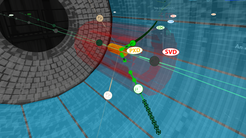News
BELLE II DELIVERS FIRST RESULTS
In search of the Z’ boson
04/07/2020

The Belle II experiment started almost exactly a year ago. The renowned journal Physical Review Letters is now publishing the first results of the detector. The work deals with a new particle in connection with dark matter, which, according to current knowledge, makes up about 25 percent of the universe.
The Belle II experiment has been taking data for physical measurements for about a year. Both the SuperKEKB electron-positron accelerator and the Belle II detector had been refurbished over several years in order to achieve a 40 times higher data rate.
Scientists at twelve institutes in Germany are significantly involved in the construction and operation of the detector, the development of evaluation algorithms and the analysis of the data. The Max Planck Society's semiconductor laboratory made a key contribution to the new development of the highly sensitive innermost detector, the pixel vertex detector.
With Belle II, scientists are looking for traces of new physics that can be used, for example, to explain the unequal occurrence of matter and antimatter or the mysterious dark matter. One of the previously undiscovered particles that the Belle II detector is looking for is the Z'-boson - a variant of the already detected Z-boson. The latter acts as an exchange particle for the weak interaction.
As far as we know, about 25 percent of the universe is made up of dark matter, whereas visible matter makes up just under 5 percent of the energy budget. Both forms of matter attract each other via gravity. Dark matter forms a kind of template for the distribution of visible matter, which is shown, for example, in the arrangement of galaxies in the universe.
